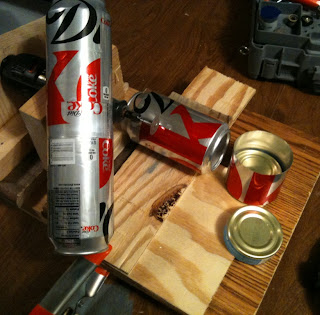TIME TO IMPROVISE !
Here I'm now focusing on the issue of joining the cans in such a manner as to eliminate the problems of melting glue and mechanical connectors that would no doubt cause corrosion. So lets make the connections out of the same cans that were being used originally.
There is a lot of information in this picture so examine it carefully! In the center of the picture is the Dremel with the #409 cut-off wheel.The can that is laying on it's side is braced against a piece of wood (darker wood) behind, and another brace at the top of the can toward the Dremel. This way I can just pull the board and can toward me slightly and rotate the can while the cutter does it's job. Notice the band already cut to the right.
If you look at the two cans that have been joined by a band on the left side of the photo, the band is a bit narrower since it's joining two cans that are oriented bottom-to-bottom. If you look real close, you can actually see the impression from the cans beneath, about 1/4-inch inside the cuts. The attachment is much stronger than the glued versions, and will not be affected by the heat.
Referring to the band on the right again, notice the cans, one in the cut band, and one outside the band. I knew that if I were lucky enough to push the can into the band easily, then I needed something to stop the can from going beyond a halfway point. These are "Fancy Feast" cans (cat food) nicely cleaned by the kitties and then cut with the same #409 cut-off wheel. They "can" act as a stop.
Besides having a great connection, there are a few other observations to bring to light. I only put the can in the freezer and left the band at room temperature. Once both cans were in place, I saw that I have probably a 1/4-inch gap between the cans on the inside. They could have traveled another 1/8th inch each to butt-up against each other. So here's the next question. Would air flow over the gap be adversely affected enough to warrant more effort to get the cans against each other, or would the heat that will be generated on the band be extracted more efficiently with the gap?
Heat generated would no doubt transfer from the band and through the cans anyway, so I will try the following. Regardless of the plastic coating on the can, I will heat the band (or the band plus the already attached can) to 300 degrees F in my oven. The other can (or the first can) will go to the freezer. If the expansion of the heated band, and contraction of the can is more pronounced, I may easily get the extra 1/8th inch (down to the cat food can stopper).
What makes the aluminum can such a good conductor will work against me as the cold can will heat up fast, while the hot band will also contract pretty fast. Lets see what can be accomplished !

No comments:
Post a Comment